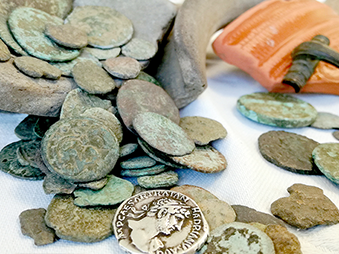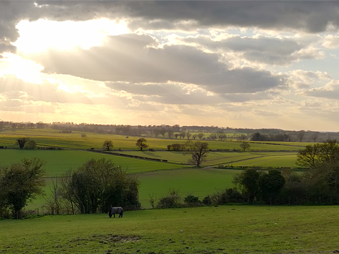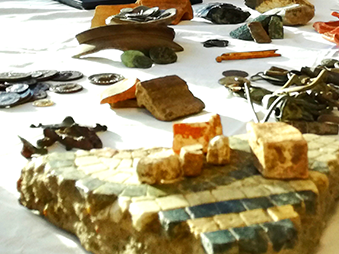Is it ‘Treasure’?
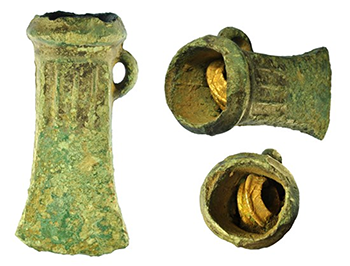
Image: Bronze Age Axehead
The following finds are Treasure under the 1996 Treasure Act:
- Any metallic object, other than a coin, which is over 300 years old when found and provided that at least 10 per cent by weight of metal is precious metal (gold or silver). If the object is of prehistoric date it will be Treasure provided any part of it is precious metal.
- Any group of two or more metallic objects of any composition of prehistoric date that come from the same find (see below).
- Two or more coins from the same find which are at least 300 years old when found and contain 10 per cent gold or silver. If the coins contain less than 10 per cent of gold or silver there must be at least ten of them. Only the following groups of coins will normally be regarded as coming from the same find: Hoards that have been deliberately hidden; Smaller groups of coins, such as the contents of purses, that may have been dropped or lost; Votive or ritual deposits.
- Any object of any material that is found in the same place as, or had previously been together with, another object that is Treasure. Finds may have become scattered since they were originally deposited in the ground.
- Any object that would previously have been treasure trove but does not fall within the specific categories given above. Only objects that are less than 300 years old, that are made substantially of gold or silver, that have been deliberately hidden with the intention of recovery and whose owners or heirs are unknown will come into this category.
What should I do if I find treasure?
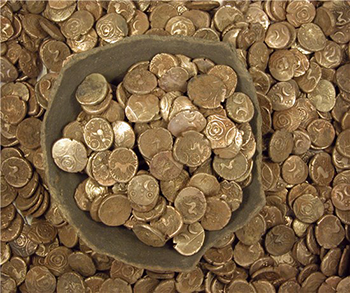
Image: Iron Age coin hoard of 840 gold staters. The vessel is also Treasure by association with the hoard.
You are legally obliged to report all finds of Treasure to the coroner within 14 days (or within 14 days of the day on which you realised that the find might be Treasure).
We can help you to do this and report the find to the coroner on your behalf, so if you think you may have an item of Treasure please contact us as soon as possible on 01284 741230 or by e-mail at sccasfinds@suffolk.gov.uk
If you find any thing complex that requires excavating, it is best to stop and contact us for advice
What you need to know about the new changes to the Treasure Act
Following several years of public consultations new significance-based criteria are now in the process of being added to the 1996 Treasure Act.
Although the Government has now laid the statutory instrument required to introduce these changes this has yet to be passed. The proposed changes are due to be debated in Parliament on 13th March in the House of Commons and 28th March in the House of Lords.
What objects will fall under the new criteria?
The changes are being implemented to ensure that very unusual, nationally significant base-metal items that do not meet the current criteria of treasure can be acquired by UK museums for public benefit.
The existing Treasure Act criteria are not changing in any way and the current procedure for reporting potential treasure remains in place.
Only metal objects and coins that do not meet the existing criteria and are more than 200 years old will qualify and only if they provide exceptional insight into an aspect of national or regional history, archaeology or culture because of one of more of the following factors:
- It is a rare example of its type;
- The location in which it was found;
- Its connection with a particular person or event;
- Significant artefact groups or assemblages.
This definition sets a very high bar, and we anticipate that only obviously exceptional objects will qualify, for example objects like the Crosby Garrett helmet and the Abergavenny Leopard Cup, that were lost to the nation when they were bought privately.
Will this lead to many more objects being reported?
In Suffolk it seems unlikely that the new significance-based criteria will substantially increase the number of objects that are reported as treasure as very few finds reported to us currently satisfy any of the above criteria.
How will I know if my object might fall under the new criteria?
The new criteria have a degree of ambiguity and there is likely to be a teething process during which new precedents are set by coroners leading to greater levels of clarity.
There continues to be a legal requirement that any find that falls under the existing or new criteria should be reported to the county coroner within 14 days but do be aware that this means 14 days after realising the find may be treasure. We do understand that finders may not realise that their find might fall under the new significance-based criteria until they have sought other opinions and/or spoken to their local Finds Liaison Officer.
The Suffolk Finds Recording Team are here to help and advise you at every stage of the reporting process if you think you may have an item of potential treasure. If we think that your item may need to be reported under the new definition this will be done in consultation with yourselves, the landowner and a range of experts and ultimately the County Coroner will make the final decision.
How will I know if my object might fall under the new criteria?
The following sections of the new Code of Practice outline the significance-based criteria in more detail:
28. This class of treasure is designed to capture only those objects that, by virtue of factors such as their rarity, provide an exceptional insight into an aspect of national or regional history, archaeology or culture. The new class was introduced in 2023 and is referred to in this Code as the ‘significance-based class of treasure’.
29. Any metal object or coin that is more than 200 years old, that does not meet any of the other classes of treasure described above, but which satisfies the test set out in Article 3(2) of the Order (as amended by the treasure (Designation)(Amendment) Order 2023) (the ‘significance criteria’), is treasure.
30. As the age limit for the new class of treasure is 200 years or older, not 300 as applies to most other classes of treasure, finds of precious metals (ie. Gold or silver) which are dated to between 200 and 300 years old can be considered treasure if they meet the significance criteria.
31. Single coins will be treasure where they meet the significance criteria.
32. An object will satisfy the significance criteria if it provides an exceptional insight into an aspect of national or regional history, archaeology or culture because of one of more of the following factors: .
- It is a rare example of its type (Section B. 34)
- The location in which it was found (Section B. 35)
- Its connection with a particular person or event (Section B. 36).
33. An object which does not meet that test on its own may satisfy the significance criteria if it is part of the same find as one or more other objects, and the group of objects, when considered together, provides an exceptional insight by virtue of one or more of the factors set out above (Section B. 37).
34. A rare example of its type. An object may be considered to meet the definition if its rarity leads to information that provides an exceptional insight into an aspect of national or regional history, archaeology or culture. Objects could be rare but not provide such an insight and would therefore not be treasure. There are a number of ways that an object may be considered rare, including:
- if it meaningfully expands the known UK corpus of examples of a particular object type, object form, art-style or evidence of manufacturing technique and provides an exceptional insight into them;
- if it has a high level of preservation or completeness in comparison with other known examples. For example, where a find is of a type that is not rare, but other known examples are in a poor or fragmentary condition, and the fact of its high level of preservation provides an exceptional insight into aspect of national or regional history, archaeology or culture;
- The rare or unusual way it was used, treated or modified during its use-life in the past means it provides an exceptional insight into an aspect of national or regional history, archaeology or culture.
35. Location of the find. An object may fall under this criteria if it provides an exceptional insight into the specific history or culture of a place due to the location in which it was found (whether by virtue of the specific location, the region, or the part of the UK – England, Wales or Northern Ireland – in which it was found). This may be because of the rarity of finds of a similar type (Section B. 34) in that location, region, or part of the UK.
36. Connected with a particular person or event. An object may satisfy the significance criteria where it can be closely associated with a particular person or event of historic importance and provides a significant insight into the understanding of that person or the event. There should be strong positive evidence of such an association; where the association is tenuous and the object does not contribute to a singular insight or Church of England jurisdiction understanding of that person or event, the find will not normally be considered treasure.
Relevant links
You may find the following links helpful:
The statutory instrument for widening the definition of treasure has now been laid before Parliament: https://www.legislation.gov.uk/ukdsi/2023/9780348244854/contents. This is due to be debates in Parliament on 13th March in the House of Commons and 28th March in House of Lords
A new final version of the Treasure Act Code of Practice has been created see here: https://www.gov.uk/government/publications/draft-treasure-act-1996-code-of-practice-3rd-revision which goes into the significance based criteria in more detail on p.14-16. This was debated in parliament last month.
Research by Heyworth Heritage carried out during the initial consultation process exploring the impact of different proposed options: https://assets.publishing.service.gov.uk/government/uploads/system/uploads/attachment_data/file/1135947/Heyworth_Report.pdf
DCMS press release: https://www.gov.uk/government/news/thousands-more-treasures-to-be-saved-for-the-nation-as-rules-about-discoveries-are-changed
National Guidance
further information about Treasure finds and the Treasure Act is available on the Portable Antiquities Scheme website
finds.org.uk »